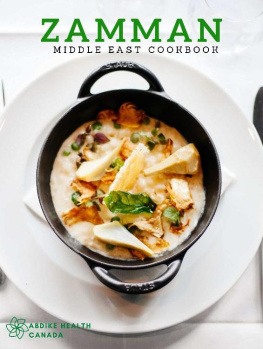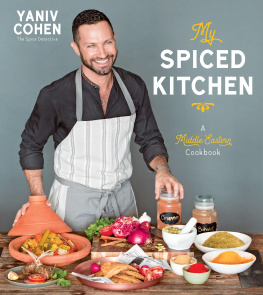CONTENTS

Cooking should be an enjoyable experience. It should also open doors to many cultures and creeds, and its acceptance and appreciation should not be clouded by politics or prejudice. Middle Eastern cooking, as presented here, is open to controversy, but not for these reasons.
First the selection of the countries is controversial, as the area covered includes Greece, Cyprus, Turkey and Armenia. More correctly, perhaps, the title should have been Near and Middle Eastern Cookbook, though Greece and Turkey are regarded as the eastern boundaries of Europe. There seemed to be only one course open to me to delve into the regions early history and justify the inclusion of certain countries from that viewpoint. Pure geography has also played a part, as the area covered fits rather neatly between longitudes 20E and 70E, and between latitudes 15N and 45N.
The region encompasses the birthplace of civilisation and its history goes back as far as 3500 BCE with a pre-history dating back to 10,000 BCE. The Mesopotamian, Assyrian, Ancient Egyptian, Phoenician, Hebrew, Minoan, Mycenaean, Ancient Greek and Persian civilisations all flourished within this area, and their contributions to world knowledge cannot be disputed. In pre-history humans first learned to harness nature, and farming had its tenuous beginnings in the area now known as Kurdistan, stretching from southeast Turkey across to northern Iran.
It is on this basis that the countries have been selected, for Middle Eastern cookery has evolved over several thousand years.
The second area of controversy relates to the actual recipes. Which dish really originated in which particular country? Again, history can solve this in part; however, there has been so much interchange of culture through trade, migration, colonisation, invasion and counter-invasion that even this presents difficulties. So many similar recipes turn up in the culinary repertoire of a number of countries that to trace the source of many of them is virtually impossible. There are dolmas with variations in both name and ingredients stretching from Greece to Afghanistan and south to the Arab Gulf States; keftethes in Greece gradually change in name and character to kofta in Afghanistan; a sweet preserve made from green walnuts is made in Greece and Cyprus and the same delicacy is prepared in Iran, but nowhere else in between; there are variations on the Greek kourabiethes and the Gulf States ghiraybah in every other country of the region.
Do not assume that the book is a collection of a group of recipes with countless variations I have avoided this as far as possible for the scope of Middle Eastern cooking surprised me as much as it will probably surprise you.
Food and its preparation around the world have almost come full circle. (I say almost, for many aspects have of course changed, and will continue to do so this is the essence of civilisation. There has been change in the manner of cultivation and the raising of livestock, though there are areas in the region where primitive methods are still employed; and there has been change in cooking methods.)
People have realised that highly refined foods are responsible for a number of their ailments; nutrition experts now advocate a diet based on simple, natural foods meats, fish, poultry, less refined cereals, pulses, vegetable oils, pure butter and ghee, vegetables, fruit, nuts, yoghurt and cheese. And these, along with herbs and spices, are what Middle Eastern cooking is all about a diet basically unchanged for thousands of years.
Western kitchen appliances the electric blender, food processor, grinder, mixer and juicer cut down on preparation time considerably. Many ingredients you will already have or be familiar with; the others are readily available at Middle Eastern, Greek and Armenian food stores, and at specialised food stores such as those stocking natural foods. The glossary will assist you greatly as it gives the various names for particular ingredients, and which substitutes, if any, may be used for unusual or hard-to-come-by ingredients.
Now let us mount the magic carpet for a culinary tour of the mystical, exotic world of Homer, the Arabian Nights and Omar Khayyam. Ahlan wasahlan! (Welcome!)

Tess Mallos
Many foods are common to most Middle Eastern countries. Though most recipes give full details of their preparation, here is some basic information for easy reference.
Okra
Wash well, handling the okra gently. Trim the stem end without cutting the pod. If desired, trim around the conical stem attached to the pod, removing a thin layer. This is the correct way to prepare okra, but it is time consuming and only serves to remove the fine brown ring just above the pod and the outer layer of the stem. Middle Eastern cooks prefer to do this as the whole vegetable is then edible.
Fuzz can be removed if desired by rubbing the pod gently with a fine nylon scourer. Do this under running water. If the okra is young, there is no need to remove fuzz. Dry the okra well in a cloth, or spread out and leave until dry.
Place in a bowl and pour 125 ml (4 fl oz/ cup) vinegar over each 500 g (1 lb 2 oz) okra. Toss gently using your hands so that the vinegar coats the okra. Leave for 30 minutes, drain and rinse well. Dry and use as directed in recipes. The vinegar treatment stops the okra becoming slimy during cooking.
FREEZING OKRA
As fresh okra are available for only a short time, it is worthwhile freezing some if tinned or frozen okra are not readily available.
Method I: Prepare as directed above, then dry. In a deep saucepan, heat 2 tablespoons olive oil for each 500 g (1 lb 2 oz) okra. Fry the okra for 5 minutes, tossing gently with a wooden spoon. Cool, place in freezer bags, expel the air, then seal and label. Place in the freezer.
Method II: Prepare as above. Bring a large saucepan of water to the boil. Have ready a bowl of iced water. Place the prepared okra in a frying basket and lower into the boiling water. Boil for 3 minutes, timed from when the water returns to the boil. Lift out and place in iced water for 3 minutes. Drain well, pack and store in the freezer.
Globe artichokes
Have ready a large bowl of cold water, with the juice of 1 lemon and some lemon slices added. If desired, stir in 23 tablespoons plain (all-purpose) flour, as this is quite effective in preventing discolouration.
Wash the artichokes well and cut off the stem close to the base. As each artichoke is prepared to requirements, rub the cut surfaces with a lemon slice from the bowl and place in the bowl until all are prepared. Cook as soon as possible after preparation.
Whole artichokes: Remove the tough outer leaves and trim carefully around the base, just enough to neaten. Cut off 3 cm (1 inches) from the top and trim the remaining leaf ends with scissors. If the artichokes are of a good shape and quality, it is not necessary to trim the leaf ends.
Artichoke hearts: As for whole artichokes, only remove three or four layers of leaves, until the tender inner leaves remain. Scoop out the hairy choke and pink thorny leaves from the centre, using a spoon or melon ball scoop. Leave whole, or cut in half.
















